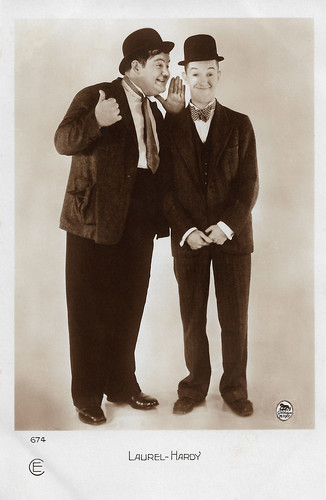
French postcard by Cinémagazine-Edition, Paris, no. 674. Photo: Goldwyn Mayer (MGM). Collection: Geoffrey Donaldson Institute.

Dutch postcard, no. 86. Photo: Metro-Goldwyn-Mayer.
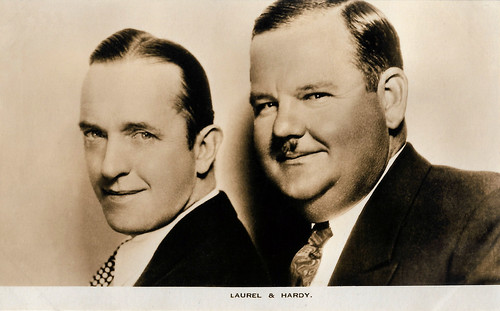
British postcard by Film Weekly, London.

French postcard by Editions La Malibran, Paris, no. CA 37. Stan Laurel and Oliver Hardy play 'In the Good Old Summertime' in Below Zero (James Parrott, 1930).
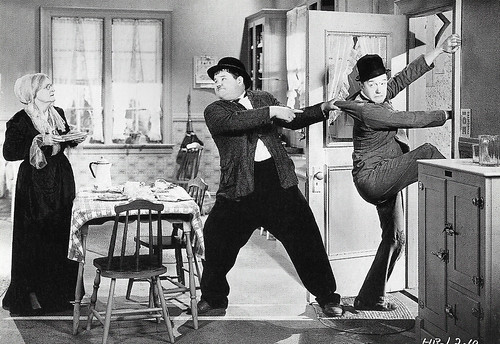
French postcard by Editions La Malibran, Paris, no. CA 78. Mary Carr, Stan Laurel and Oliver Hardy in One Good Turn (James W. Horne, 1931).

Big Italian card in the Sotto le Stelle del Cinema series by Cineteca Bologna, 2017. Stan Laurel and Oliver Hardy in Sons of the Desert (William A. Seiter, 1933).
Putting pants on Philip
Before their being teamed up, Stan Laurel and Oliver Hardy both had well-established film careers. Stan Laurel had appeared in over 50 films and Oliver Hardy had been in more than 250 productions. Stan Laurel was born in 1890 as Arthur Stanley Jefferson in Ulverston, England into a theatrical family. His father Arthur Joseph Jefferson was a theatrical entrepreneur and theatre owner in northern England and Scotland who, together with his wife, was a major force in the industry. He made his stage debut in the Britannia Panopticon in Glasgow one month short of his 16th birthday. In 1909, Laurel was employed by Britain's leading comedy impresario Fred Karno as a supporting actor, and as an understudy for Charlie Chaplin.
In 1912, Jefferson left England with the Fred Karno Troupe to tour the United States. He had expected the tour to be merely a pleasant interval before returning to London; however, he emigrated to the U.S. during the trip. In 1917, Stan Jefferson made his film debut with his first wife Mae Dahlberg in Nuts in May. From then on he began using the name, Stan Laurel. In 1931, he changed his name legally. With his early silent films, he experienced only modest success. It was difficult for producers, writers, and directors to write for his character, with American audiences knowing him either as a 'nutty burglar' or as a Charlie Chaplin imitator.
Oliver Hardy was born Norvell Hardy in Harlem, Georgia, in 1892. As a boy, he was a gifted singer, and by age eight, was performing in minstrel shows. By his late teens, Hardy operated a cinema in Milledgeville, Georgia, the Palace Theater, financed in part by his mother. In 1913, he began working as a comic actor with Lubin Motion Pictures in Jacksonville. For his stage name, he took his father's first name calling himself Oliver Norvell Hardy while offscreen his nicknames were Ollie and Babe. Hardy was billed as Babe Hardy in his first film, Outwitting Dad (Arthur Hotaling, 1914). Between 1914 and 1916, Hardy made 177 shorts as Babe with the Vim Comedy Company that were released up to the end of 1917. He showed versatility in playing heroes, villains and even female characters, Hardy was in demand for roles as a supporting actor, comic villain or second banana. For 10 years he memorably assisted star comic and Charlie Chaplin imitator Billy West, Jimmy Aubrey, Larry Semon, and Charley Chase.
The two comedians first worked together as cast members in the film The Lucky Dog (Jesse Robbins, 1921). Though they appear in scenes together, they play independently of each other and not as the comedic team that they would later become. In fact, they did not see each other for another 2 or 3 years. In 1926, both separately signed contracts with the Hal Roach film studio, and then they appeared again in a silent short film together.
Laurel and Hardy officially became a team in the silent short film Putting Pants on Philip (Clyde Bruckman, 1927). Laurel plays Philip, a young Scot who newly arrived in the United States, in full kilted splendour, suffering mishaps involving the kilt. His uncle, played by Oliver Hardy, is shown trying to put trousers on him. The idea for the film was Stan Laurel's and was based on a story recounted by a friend while Laurel worked in a music hall. Although Putting Pants on Philip was their first 'official film as a team, the iconic Stan and Ollie characters and costumes had yet to become a permanent fixture. Their first appearance as the Stan and Ollie characters was in The Second Hundred Years (Fred Guiol, 1927). The film was supervised by Leo McCarey, who suggested that the performers be teamed permanently. They became a huge hit as a comedy team, and after several years of two-reelers, Roach decided to star them in features. Their first feature-length starring roles were in Pardon Us (James Parrott, 1931).
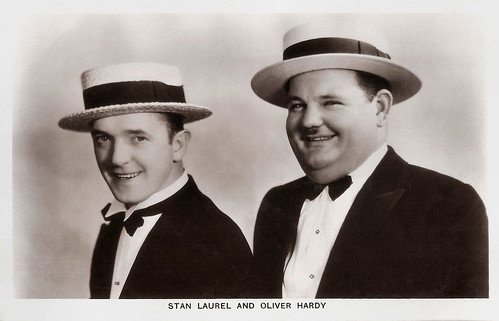
British postcard in the Picturegoer Series, London, no. 491.

French postcard by Editions P.I., Paris, offered by Kes Carbones Korès Carboplane, no. 221, 1951. Photo: Metro Goldwyn Mayer (MGM).

Dutch postcard by Forte.
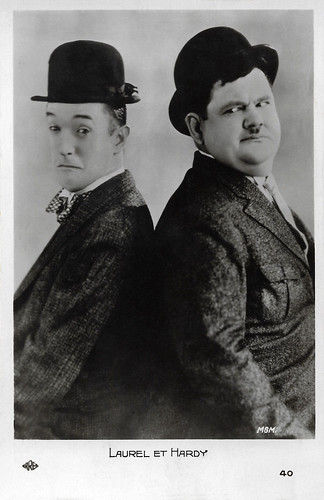
French postcard by Erres, no. 40. Photo: Metro-Goldwyn-Mayer.

British 'Real Photograph' postcard by Moviestar, no. F 54.

British 'Real Photograph' postcard by Moviestar, no. F 56.

French postcard by A.N., Paris, no. 1028. Photo: Metro-Goldwyn-Mayer.
Well, here's another nice mess you've gotten me into!
Stan Laurel and Oliver Hardy remained with the Roach studio until 1940. Here, they starred in such classics as Sons of the Desert (1933) with Charlie Chase, Babes in Toyland (Gus Meins, Charley Rogers, 1934), Way Out West (James W. Horne, 1937), Block-Heads (John G. Blystone, 1938) and A Chump at Oxford (Alfred J. Goulding).
A popular routine the team performed was a 'tit-for-tat' fight with an adversary. This could be with their wives or with a neighbour. Laurel and Hardy would accidentally damage someone's property, with the injured party retaliating by ruining something belonging to them. After calmly surveying the damage, they would find something else to vandalize, and conflict would escalate until both sides were simultaneously destroying items in front of each other. The catchphrase most used by them is: "Well, here's another nice mess you've gotten me into!" Wikipedia: "The humor of Laurel and Hardy was highly visual with slapstick used for emphasis. They often had physical arguments with each other (in character), which were quite complex and involved cartoon violence, and their characters preclude them from making any real progress in the simplest endeavors. Much of their comedy involves milking a joke, where a simple idea provides a basis from which to build multiple gags without following a defined narrative."
From 1941 to 1945, Stan Laurel and Oliver Hardy appeared in eight B movie comedies for 20th Century Fox and Metro-Goldwyn-Mayer. Their work became more production-line and less popular during the war years. Their last Hollywood movie together was The Bullfighters (Malcolm St. Clair, 1945). From then on, they concentrated on performing in stage shows and embarked on a music hall tour of England, Ireland and Scotland. In post-World War II Europe, Laurel and Hardy were enjoying new popularity with audiences that had been unable to see their films during wartime. As a result of this, the pair received an offer from a French-Italian cinematic consortium to star in a film to be produced in France for $1.5 million, a large budget for the era.
The French/Italian co-production, called Atoll K/Utopia (Léo Joannon, 1951), would be their final film together. The film co-stars French singer/actress Suzy Delair as nightclub singer Chérie Lamour and was directed by Léo Joannon, with uncredited co-direction by blacklisted U.S. director John Berry. The production of the film was riddled with problems and critical reaction was overwhelmingly poor. As a team, Laurel and Hardy appeared in 107 films, with the pair starring in 32 short silent films, 40 short sound films and 23 full-length feature films. They also made 12 guest or cameo appearances including the Galaxy of Stars promotional film of 1936. Hardy appeared without Laurel in a few features, such as Zenobia (Gordon Douglas, 1939) with Harry Langdon, The Fighting Kentuckian (George Waggner, 1949) in a semi-comedic role as a frontiersman alongside John Wayne and Riding High (Frank Capra, 1950), in a cameo role.
In 1954 the pair made one American television appearance when they were surprised and interviewed by Ralph Edwards on his live NBC-TV program This Is Your Life. In 1960 Stan Laurel was given a special Oscar "for his creative pioneering in the field of cinema comedy". He died five years later. Oliver Hardy died in 1957. Since the 1930s, the works of Laurel and Hardy have been released in numerous theatrical reissues, television revivals, 8-mm and 16-mm home movies, feature-film compilations and home videos.

British postcard in Film Picture Stories Star Series, no. 6. Photo: Metro-Goldwyn-Mayer. Stan Laurel and Oliver Hardy in Them Thar Hills (Charley Rogers, 1934). Caption: Stan Laurel was born on June 16, 1895, in Ulverston Lancs, England. Has auburn hair, and blue eyes and is 5 ft. 9 ins in height. Oliver Hardy was born on January 18, 1982, in Atlanta, Georgia. Has black hair, and brown eyes and is 6 ft 1 inc. in height. Their most recent films include Any Old Port, Helpmates, Beau Chumps, Slippery Pearls, Pack Up Your Troubles, Fra Diavolo and Fraternally Yours.

Vintage postcard.
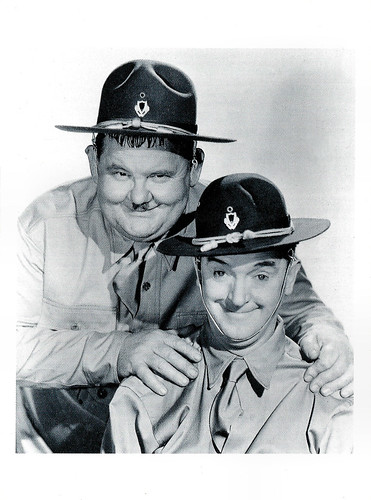
British postcard by GreenWood, 1992. Stan Laurel and Oliver Hardy in Great Guns (Monty Banks, 1941). Sent by mail in 1992 in the Netherlands.

Swiss-German-British postcard by News Productions, Baulmes / Filmwelt Berlin, Bakede / News Productions, Stroud, no. 56559. Oliver Hardy, Stan Laurel, director Harry Lachman and cinematographer Rudolph Mate on the set of Our Relations (Harry Lachman, 1936), produced by MGM.

German collector card Design: Eberhard Renziehausen, who signed as 'Rienzi'. In Germany, Laurel & Hardy are known as Dick und Doof.
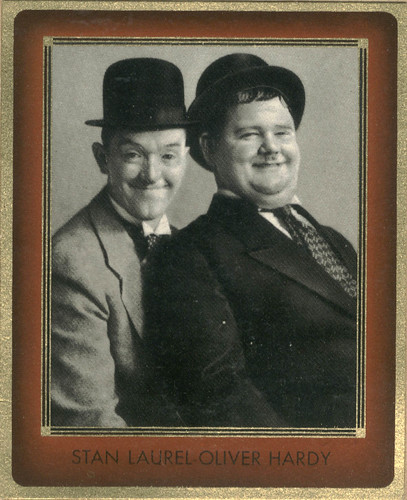
German collectors card in the Bunte Filmbilder series by Greilingen Zigaretten, no. 56. Collection: Manuel Palomino Arjona (Flickr).

Spanish collectors card by I.G. Viladot, Barcelona, presented by Dentichlor, Barcelona. Image: Cifesa.

Vintage card.
Sources: Ed Stephan (IMDb), Wikipedia and IMDb.
This post was last updated on 10 August 2024.
No comments:
Post a Comment